A Modified Leakage Localization Method Using Multilayer Perceptron Neural Networks in a Pressurized Gas Pipe
Abstract
:Featured Application
Abstract
1. Introduction
2. The Principle of Leak Location Method Based on the Generalized Cross-Correlation Function
2.1. The Modified Generalized Cross-Correlation Location Method
2.2. Wave Speed Estimation Based on Modal Analysis of Gas-Leakage-Induced Guided Waves
3. The Principle of the Leak Location Method Based on the AE Signal Energy Attenuation
3.1. AE Signal Energy Attenuation
3.2. Multilayer Perceptron Neural Networks Classifier
4. Laboratory Experiments
4.1. Experimental Setup and Data Collection
4.2. Signal Processing for Leakage Location
- 1. In the learning mode, the training sets of the MLPNN contain the input vectors and the output vectors. The input vectors are the energy ratios of two impulse response signals in corresponding frequency bands. Since the impulse response signals are non-stationary signals, and the wavelet packet analysis is suitable for processing the non-stationary signals, then the impulse response signals were processed by the wavelet packet transform in this study. The output vectors are the distances between one sensor and each impact location. The learning procedure for the MLPNN is as follows:
- Since the energy of a leakage-induced signal at frequency band from 100 to 150 kHz is higher than at other frequency bands, and three-level decomposition can extract the signal in this frequency range, so all the impulse response signals are decomposed into three layers of wavelet packet coefficients, and the signals are reconstructed in eight frequency bands by wavelet packet coefficients. The Haar wavelet is used in this study.
- Calculate the energies of the decomposed signals in step 1 by Equation (13); then calculate the energy ratios of two impulse response signals in the corresponding frequency band.
- Train the MLPNN with the input and output vectors. The input vectors are the energy ratios in step 2, and the output vectors are the distances between one sensor and each impact location, and the epochs in the training method is set to 0.01.
- 2. In the application mode, the trained MLPNN locator can locate the leakage by using the energy ratios of the leakage-induced signals in the frequency bands with greater power spectral density. The leakage location procedures for the MLPNN locator are described as follows:
- Measure the leakage-induced signals by using the two AE sensors.
- Determine the peak frequency of the leakage-induced signals by using the power spectral density.
- Estimate the group speed of the leakage-induced signals by using the peak frequency in step 2 and the known group speed dispersive curve of the fundamental flexural mode.
- Calculate the CCC by using the CCF method and the modified GCC method.
- Compare the maximum peak amplitudes of the two CCCs obtained in step 4. ρx1x2c and ρx1x2g are the maximum peak amplitudes of the CCCs obtained by using the CCF method and the modified GCC method, respectively. If ρx1x2g is greater than ρx1x2c, it implies that compared to the CCC obtained by using CCF method, the CCC obtained by using modified GCC method is more reliable; then perform step 6, otherwise perform step 7.
- Calculate the distance between the leakage and sensor 1 by Equation (9). The group speed of the leakage-induced signal was determined in step 3, and the time delay was determined by the sampling frequency and the offset of the CCC maximum peak obtained by the modified GCC method in step 4.
- Decompose the leakage-induced signals into three layers wavelet packet coefficients, reconstruct the signals in eight frequency bands by using the wavelet packet coefficients.
- Calculate the energy ratios of the decomposed signals in the frequency bands with the greater power spectral density.
- Locate the leakage by using the energy ratios in step 8 and the trained MLPNN locator.
5. Results and Discussion
5.1. Characteristics of the Frequency Domain
5.2. Characteristics of the Signal Energy Ratios
5.3. Characteristics of the Time Domain.
5.4. Leakage Location Analysis
6. Conclusions
Data Availability
Author Contributions
Funding
Conflicts of Interest
References
- Edalati, K.; Rastkhah, N.; Kermani, A.; Seiedi, M.; Movafeghi, A. The use of radiography for thickness measurement and corrosion monitoring in pipes. Int. J. Press. Vessels Pip. 2006, 83, 736–741. [Google Scholar] [CrossRef]
- Liang, W.; Hu, J.; Zhang, L.; Guo, C.; Lin, W. Assessing and classifying risk of pipeline third-party interference based on fault tree and SOM. Eng. Appl. Artif. Intell. 2012, 25, 594–608. [Google Scholar] [CrossRef]
- Vargas-Arista, B.; Hallen, J.M.; Albiter, A. Effect of artificial aging on the microstructure of weldment on API 5L X-52 steel pipe. Mater. Charact. 2007, 58, 721–729. [Google Scholar] [CrossRef]
- Ferraz, I.N.; Garcia, A.C.; Bernardini, F.C. Artificial Neural Networks Ensemble Used for Pipeline Leak Detection Systems. In Proceedings of the 7th International Pipeline Conference IPC 2008, Calgary, AB, Canada, 29 September–3 October 2008; pp. 739–747. [Google Scholar]
- Nehorai, A.; Paldi, E.; Porat, B. Detection and Localization of Vapor-Emitting Sources. IEEE Trans. Signal Process. 1995, 43, 243–253. [Google Scholar] [CrossRef]
- Xiao, Q.; Li, J.; Bai, Z.; Sun, J.; Zhou, N.; Zeng, Z.A. Small Leak Detection Method Based on VMD Adaptive De-Noising and Ambiguity Correlation Classification Intended for Natural Gas Pipelines. Sensors 2016, 16, 2116. [Google Scholar] [CrossRef] [PubMed]
- Faerman, V.A.; Cheremnov, A.G.; Avramchuk, V.V.; Luneva, E.E. Prospects of Frequency-Time Correlation Analysis for Detecting Pipeline Leaks by Acoustic Emission Method. IOP Conf. Ser. Earth Environ. Sci. 2014, 21, 012041. [Google Scholar] [CrossRef] [Green Version]
- Rewerts, L.E.; Roberts, R.R.; Clark, M.A. Dispersion compensation in acoustic emission pipeline leak location. In Review of Progress in Quantitative Nondestructive Evaluation; Springer: Boston, MA, USA, 1997; Volume 16, pp. 427–434. [Google Scholar]
- Li, S.; Wen, Y.; Li, P.; Yang, J.; Dong, X.; Mu, Y. Leak location in gas pipelines using cross-time-frequency spectrum of leakage-induced acoustic vibrations. J. Sound Vib. 2014, 333, 3889–3903. [Google Scholar] [CrossRef]
- Li, S.; Wen, Y.; Li, P.; Yang, J.; Yang, L. Determination of acoustic speed for improving leak detection and location in gas pipelines. Am. Inst. Phys. 2014, 85, 024901. [Google Scholar] [CrossRef]
- Davoodi, S.; Mostafapour, A. Modeling Acoustic Emission Signals Caused by Leakage in Pressurized Gas Pipe. J. Nondestruct. Eval. 2013, 32, 67–80. [Google Scholar] [CrossRef]
- Nishino, H.; Takashina, S.; Uchida, F.; Takemoto, M.; Ono, K. Modal analysis of hollow cylindrical guided waves and applications. Jpn. J. Appl. Phys. 2001, 40, 364–370. [Google Scholar] [CrossRef]
- Grabec, I. Application of correlation techniques for localization of acoustic emission sources. Ultrasonics 1978, 16, 111–115. [Google Scholar] [CrossRef]
- Davoodi, S.; Mostafapour, A. Gas leak locating in steel pipe using wavelet transform and cross-correlation method. Int. J. Adv. Manuf. Technol. 2013, 70, 1125–1135. [Google Scholar] [CrossRef]
- Mostafapour, A.; Davoodi, S. Leakage Locating in Underground High Pressure Gas Pipe by Acoustic Emission Method. J. Nondestruct. Eval. 2012, 32, 113–123. [Google Scholar] [CrossRef]
- Yu, X.C.; Liang, W.; Zhang, L.B.; Jin, H.; Qiu, J.W. Dual-tree complex wavelet transform and SVD based acoustic noise reduction and its application in leak detection for natural gas pipeline. Mech. Syst. Signal Process. 2016, 72–73, 266–285. [Google Scholar] [CrossRef]
- Brennan, M.J.; Gao, Y.; Joseph, P.F. On the relationship between time and frequency domain methods in time delay estimation for leak detection in water distribution pipes. J. Sound Vib. 2007, 304, 213–223. [Google Scholar] [CrossRef]
- Sun, J.D.; Xiao, Q.Y.; Wen, J.T.; Zhang, Y. Natural gas pipeline leak aperture identification and location based on local mean decomposition analysis. Measurement 2016, 79, 147–157. [Google Scholar] [CrossRef]
- Guo, C.; Wen, Y.; Li, P.; Wen, J. Adaptive noise cancellation based on EMD in water-supply pipeline leak detection. Measurement 2016, 79, 188–197. [Google Scholar] [CrossRef]
- Yang, J.; Wen, Y.; Li, P. Leak location using blind system identification in water distribution pipelines. J. Sound Vib. 2008, 310, 134–148. [Google Scholar] [CrossRef]
- Choi, J.; Shin, J.; Song, C.; Han, S.; Park, D.I. Leak Detection and Location of Water Pipes Using Vibration Sensors and Modified ML Prefilter. Sensors 2017, 17, 2104. [Google Scholar] [CrossRef]
- Knapp, C.; Carter, G. The generalized correlation method for estimation of time delay. IEEE Trans. Accoust. Speech Signal Process. 1976, 244, 320–327. [Google Scholar] [CrossRef]
- Gao, Y.; Brennan, M.J.; Joseph, P.F.; Muggleton, J.M.; Hunaidi, O. A model of the correlation function of leak noise in buried plastic pipes. J. Sound Vib. 2004, 277, 133–148. [Google Scholar] [CrossRef]
- Gao, Y.; Brennan, M.J.; Joseph, P.F.; Muggleton, J.M.; Hunaidi, O. On the selection of acoustic/vibration sensors for leak detection in plastic water pipes. J. Sound Vib. 2005, 283, 927–941. [Google Scholar] [CrossRef]
- Gao, Y.; Brennan, M.J.; Joseph, P.F. A comparison of time delay estimators for the detection of leak noise signals in plastic water distribution pipes. J. Sound Vib. 2006, 292, 552–570. [Google Scholar] [CrossRef]
- Hur, J.; Kim, S.; Kim, H. Water hammer analysis that uses the impulse response method for a reservoir-pump pipeline system. J. Mech. Sci. Technol. 2017, 31, 4833–4840. [Google Scholar] [CrossRef]
- Almeida, F.C.; Brennan, M.J.; Joseph, P.F.; Dray, S.; Whitfield, S.; Paschoalini, A.T. Towards an in-situ measurement of wave velocity in buried plastic water distribution pipes for the purposes of leak location. J. Sound Vib. 2015, 359, 40–55. [Google Scholar] [CrossRef]
- Li, S.; Zhang, J.; Yan, D.; Wang, P.; Huang, Q.; Zhao, X.; Cheng, Y.; Zhou, Q.; Xiang, N.; Dong, T. Leak detection and location in gas pipelines by extraction of cross spectrum of single non-dispersive guided wave modes. J. Loss Prev. Process Ind. 2016, 44, 255–262. [Google Scholar] [CrossRef]
- Xiao, Q.; Li, J.; Sun, J.; Feng, H.; Jin, S. Natural-gas pipeline leak location using variational mode decomposition analysis and cross-time–frequency spectrum. Measurement 2018, 124, 163–172. [Google Scholar] [CrossRef]
- Li, S.; Wen, Y.; Li, P.; Yang, J.; Wen, J. Modal analysis of leakage-induced acoustic vibrations in different directions for leak detection and location in fluid-filled pipelines. In Proceedings of the IEEE International Ultrasonics Symposium, Chicago, IL, USA, 3–6 September 2014. [Google Scholar]
- Reuben, R.L.; Steel, J.A.; Shehadeh, M. Acoustic Emission Source Location for Steel Pipe and Pipeline Applications: The Role of Arrival Time Estimation. Proc. Inst. Mech. Eng. Part E J. Process Mech. Eng. 2006, 220, 121–133. [Google Scholar]
- Mostafapour, A.; Davoodi, S. Continuous leakage location in noisy environment using modal and wavelet analysis with one AE sensor. Ultrasonics 2015, 62, 305–311. [Google Scholar] [CrossRef]
- Gopi, E.S. Algorithm Collections for Digital Signal Processing Applications Using Matlab; Springer: Dordrecht, The Netherlands, 2010. [Google Scholar]
- Ionel, R.; Ionel, S.; Bauer, P.; Quint, F. Water leakage monitoring education: cross correlation study via spectral whitening. In Proceedings of the IECON 2014—40th Annual Conference of the IEEE Industrial Electronics Society, Dallas, TX, USA, 29 October–1 November 2014. [Google Scholar]
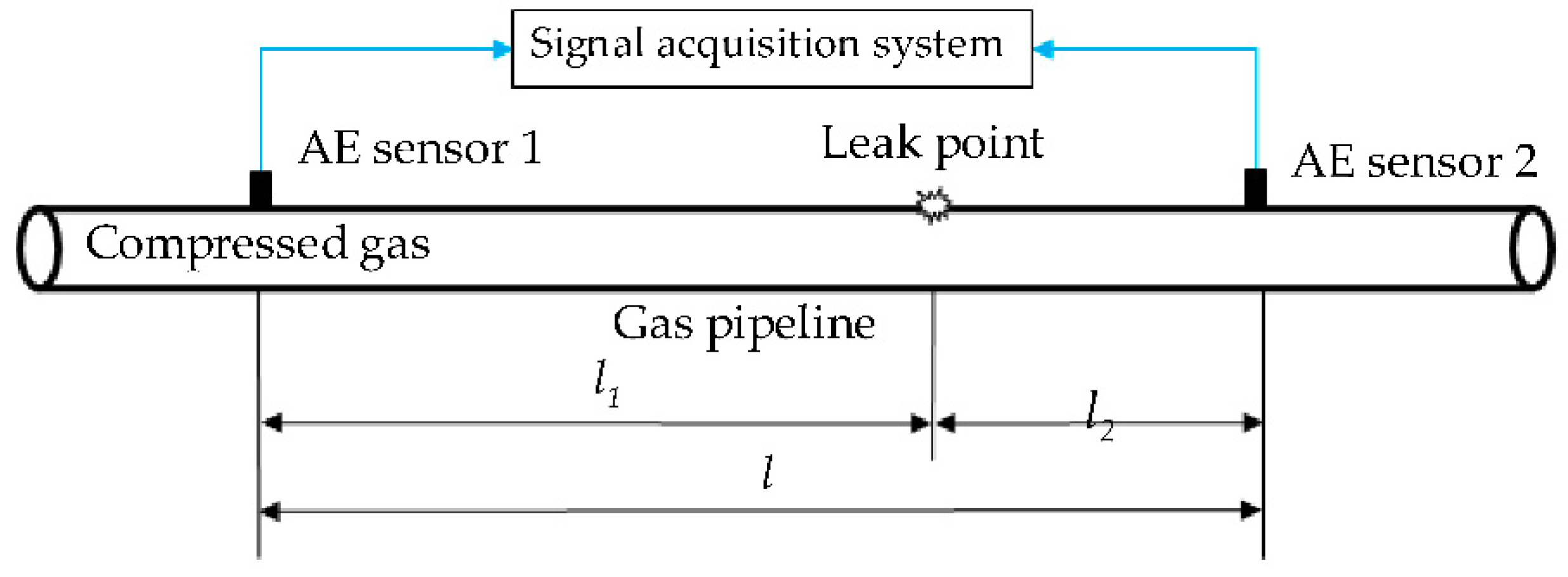

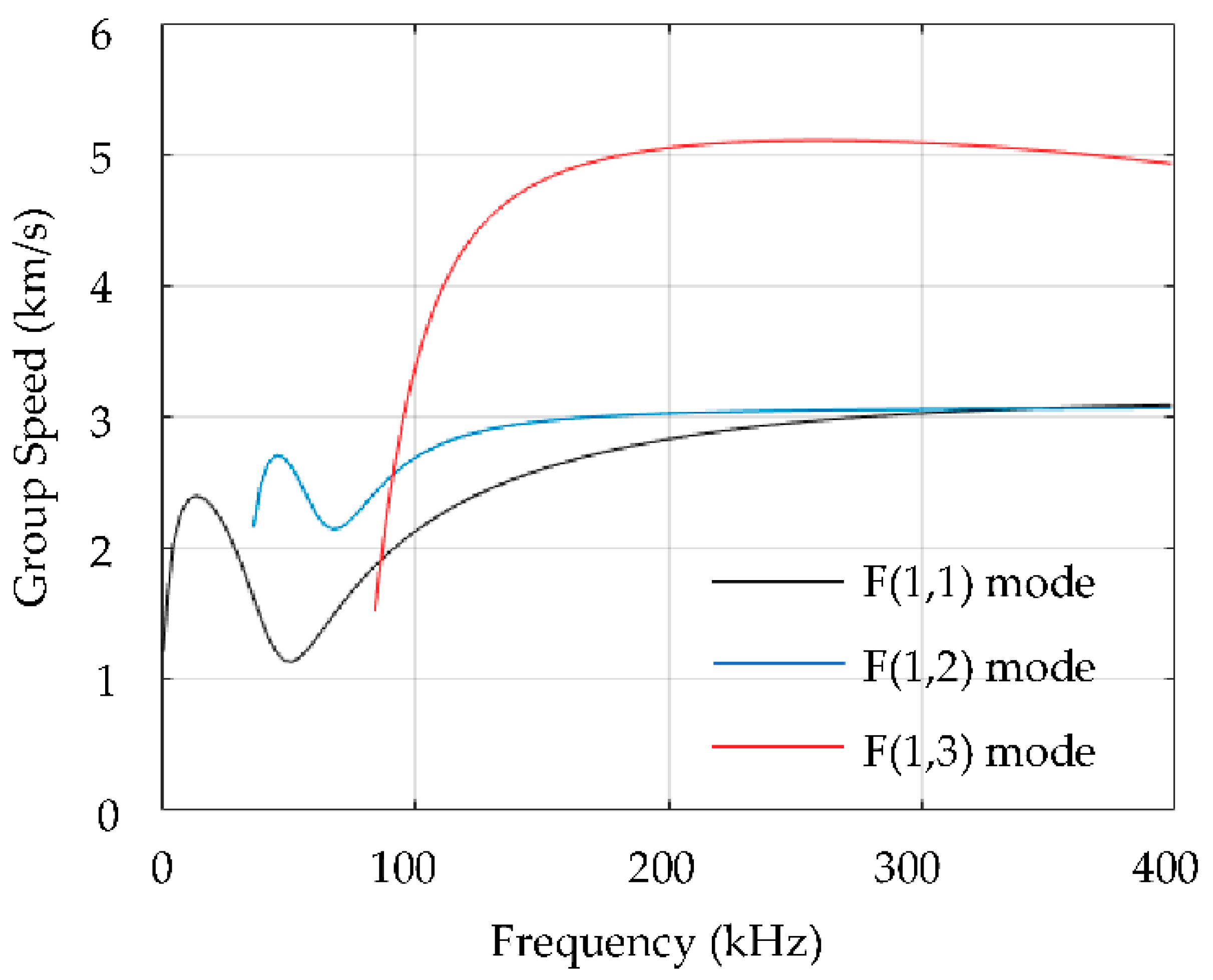
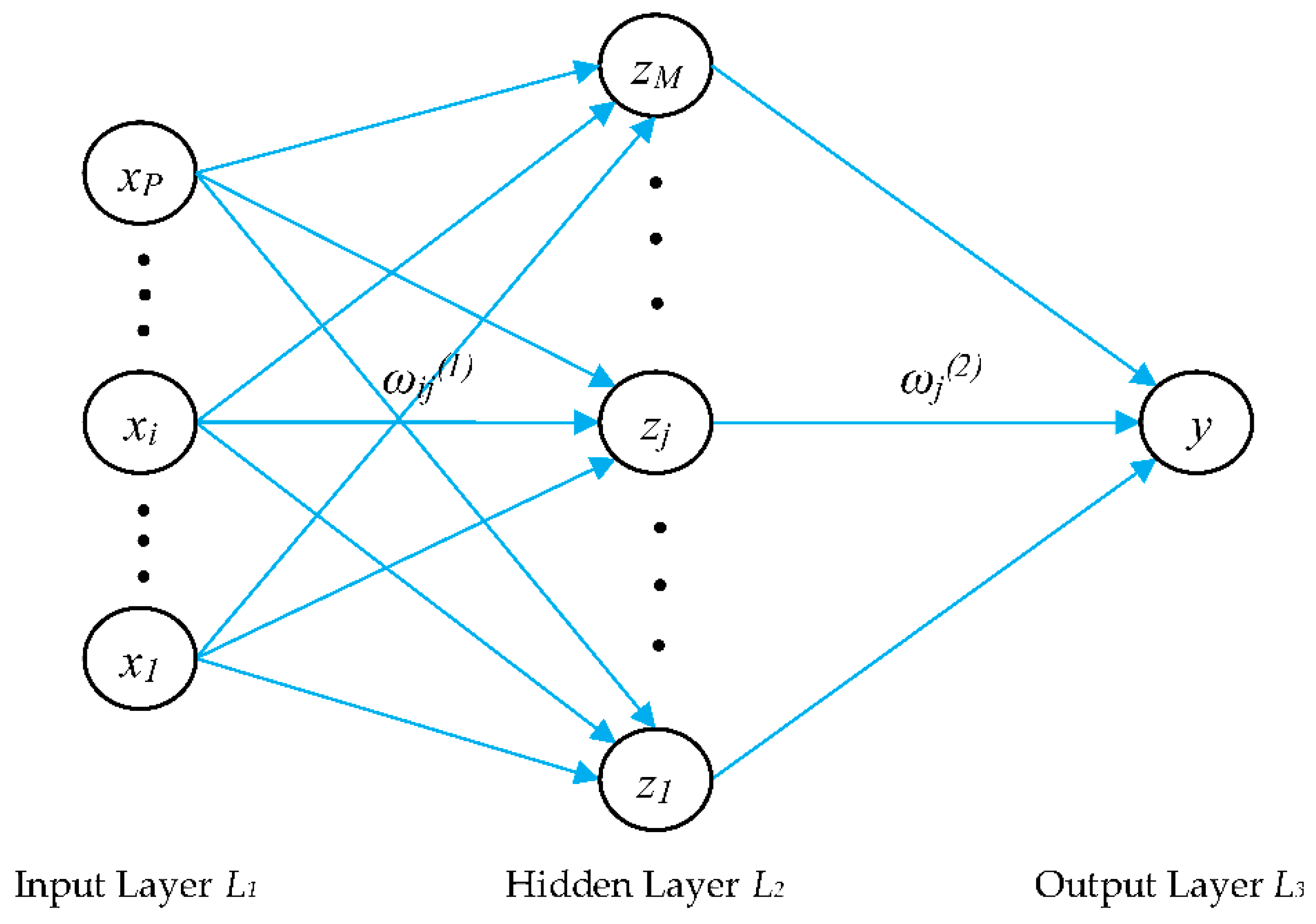
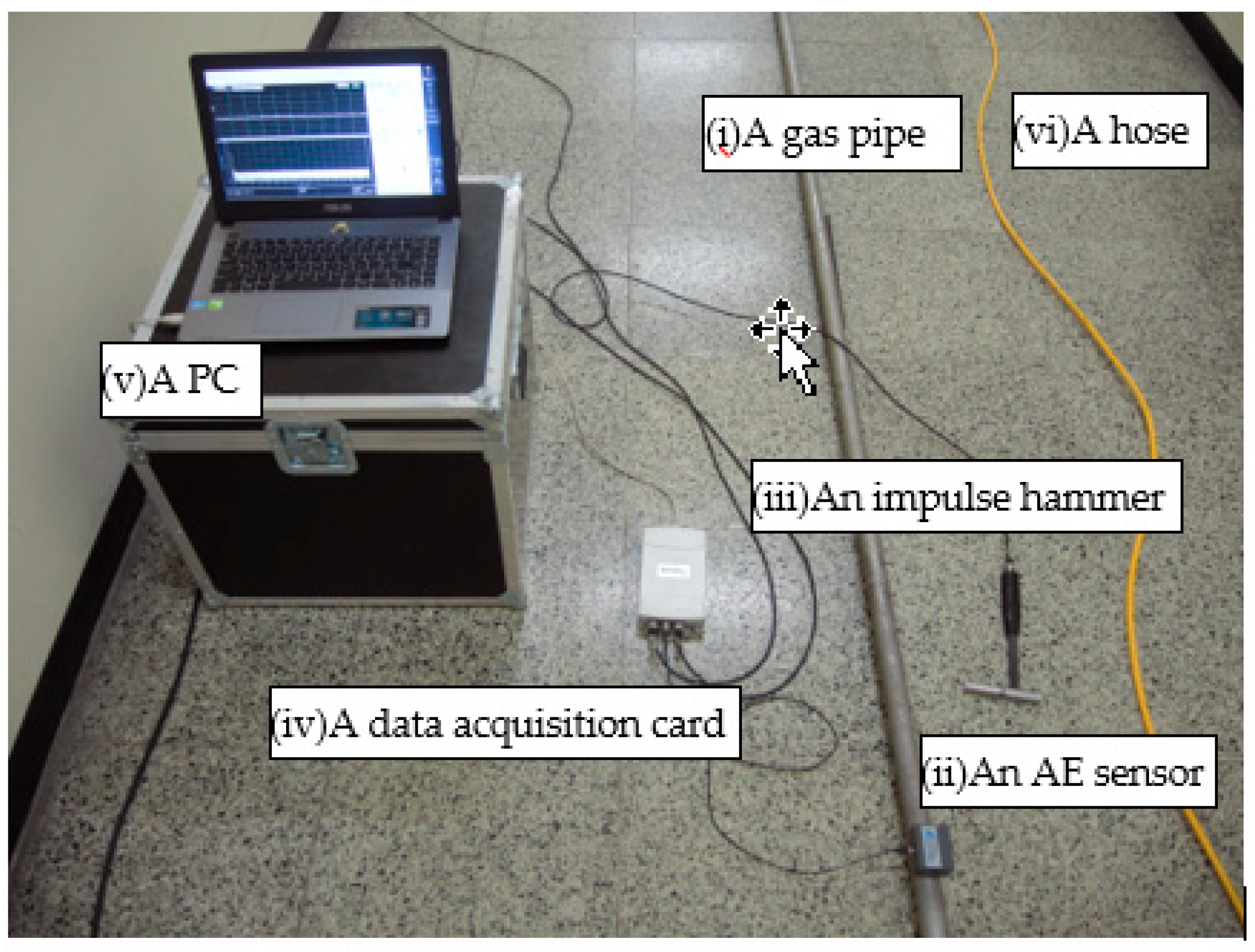
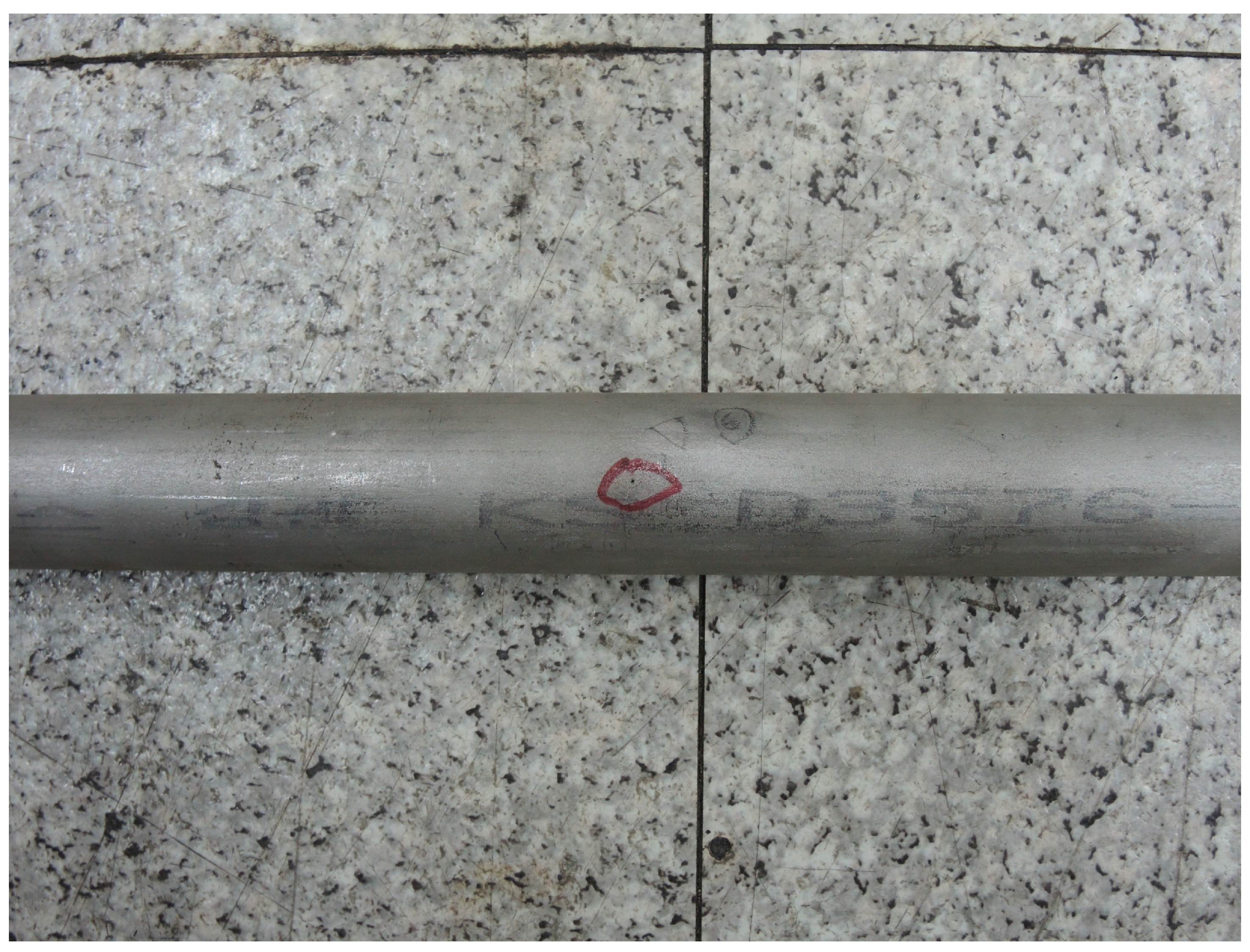
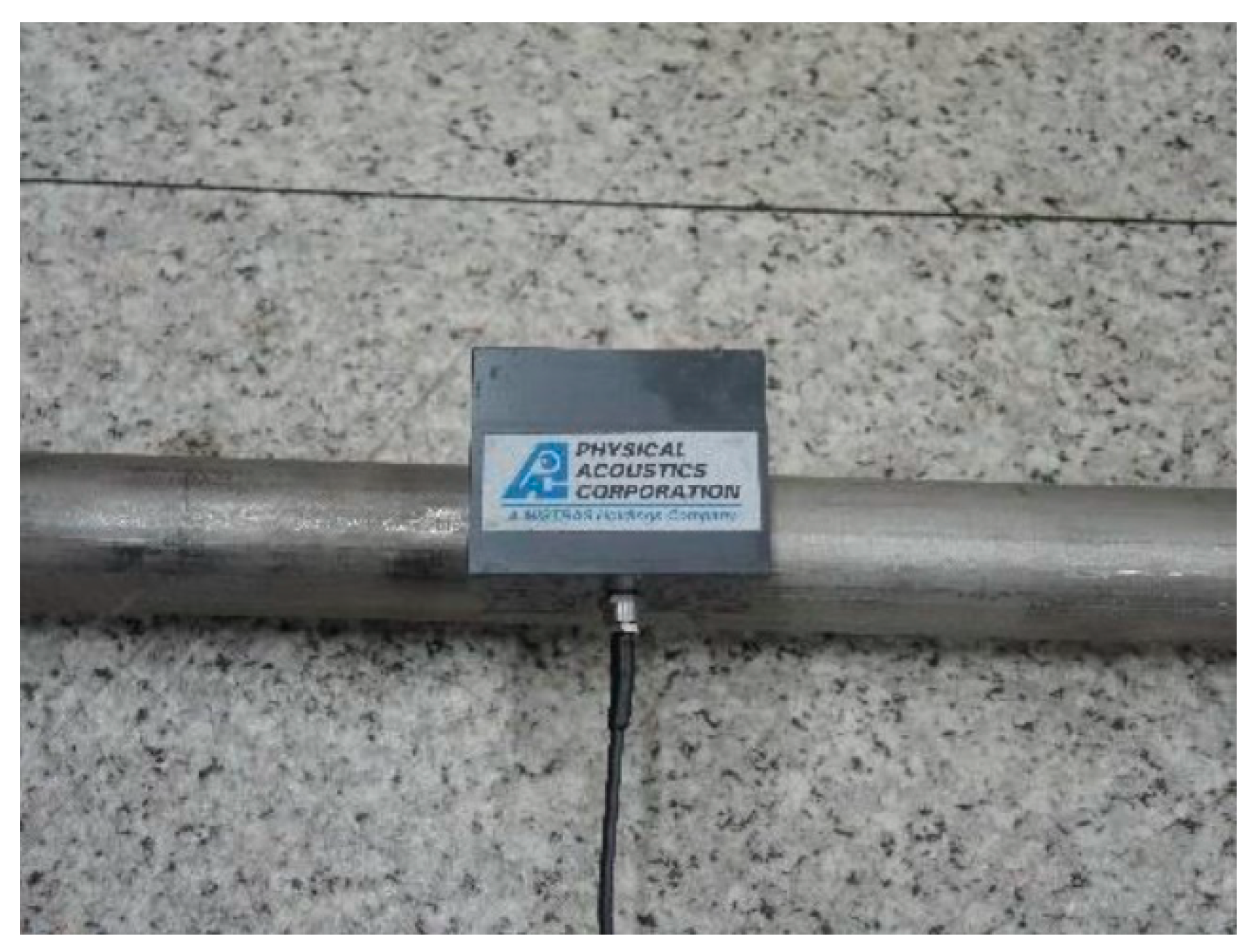
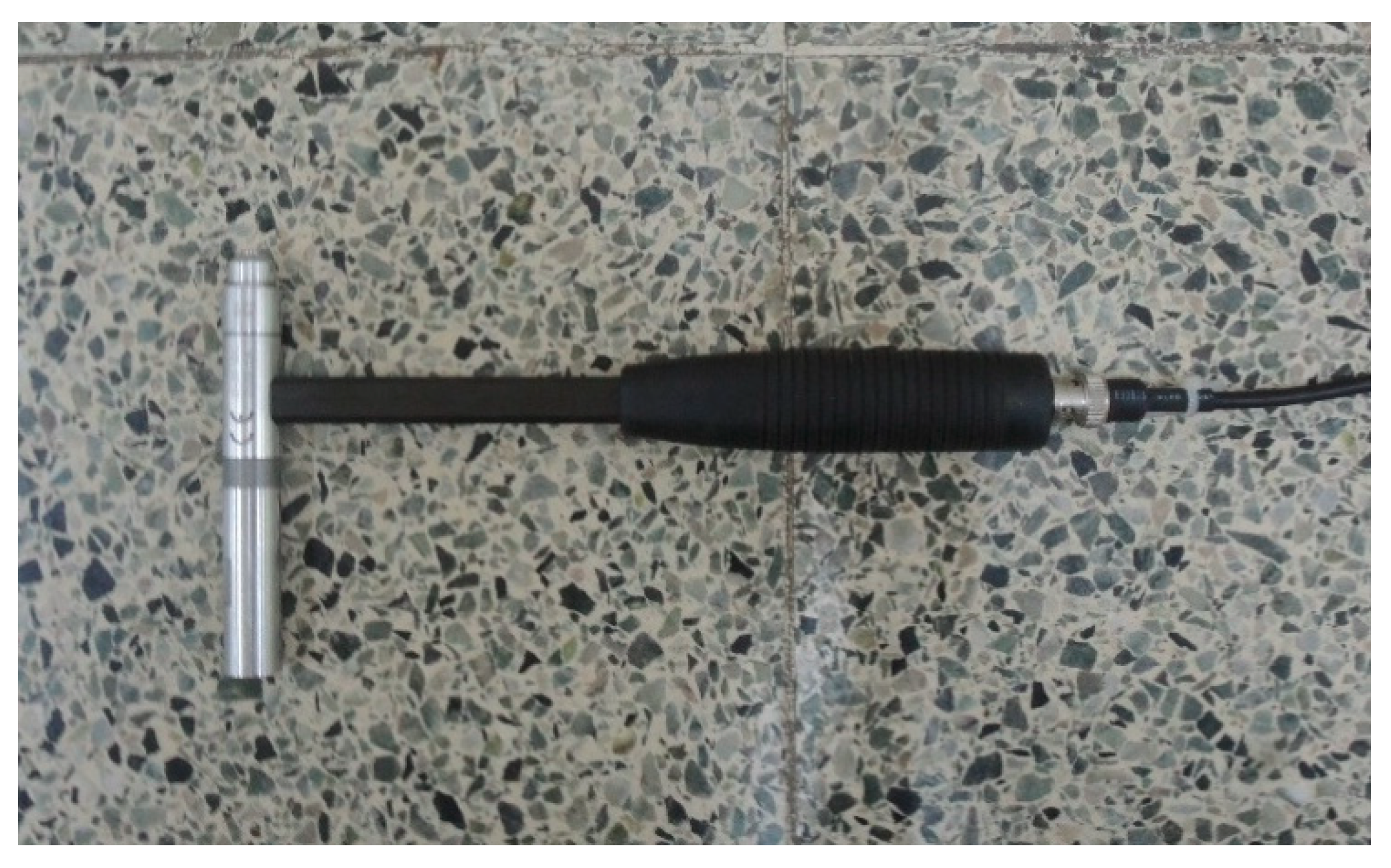
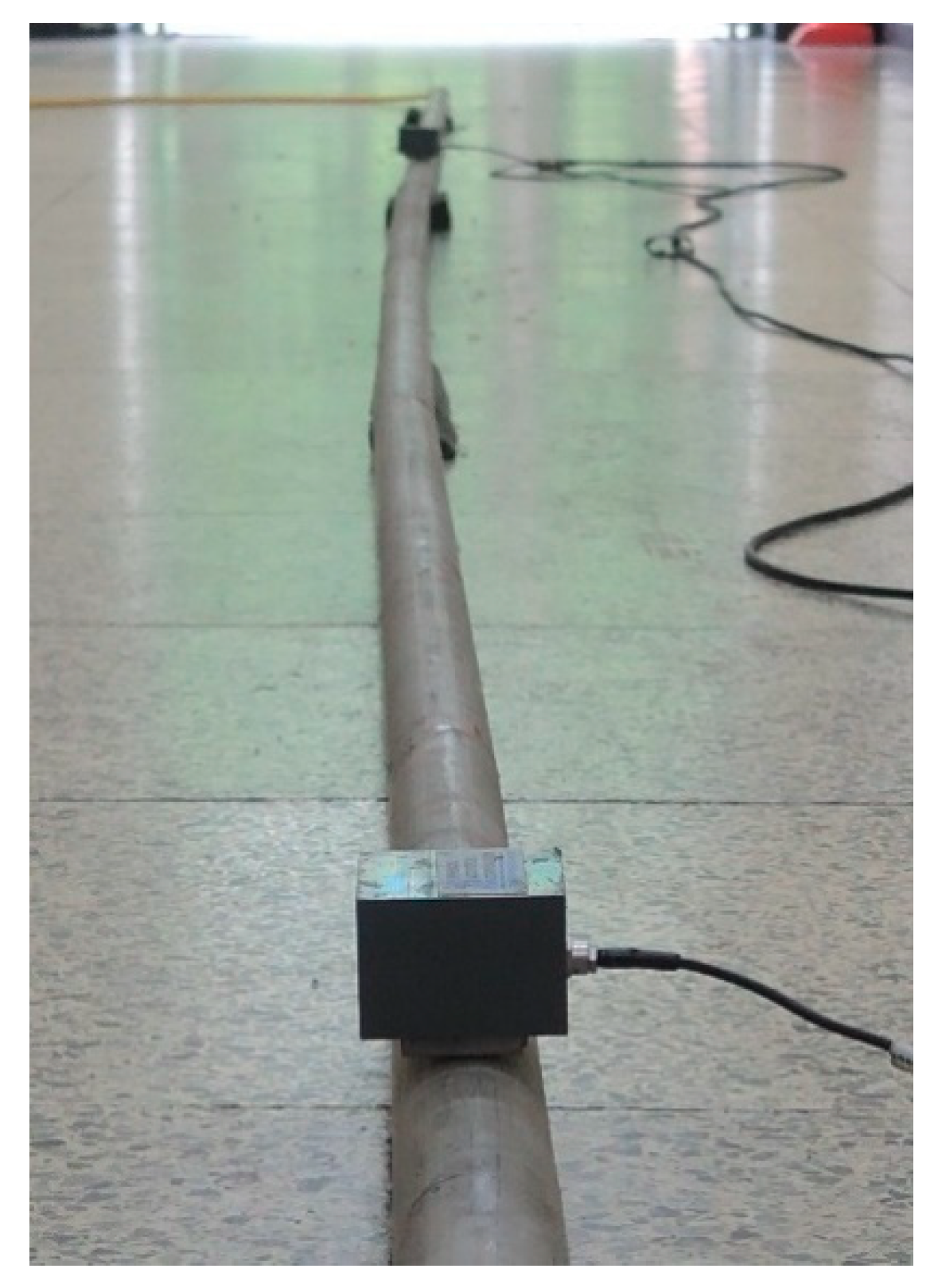
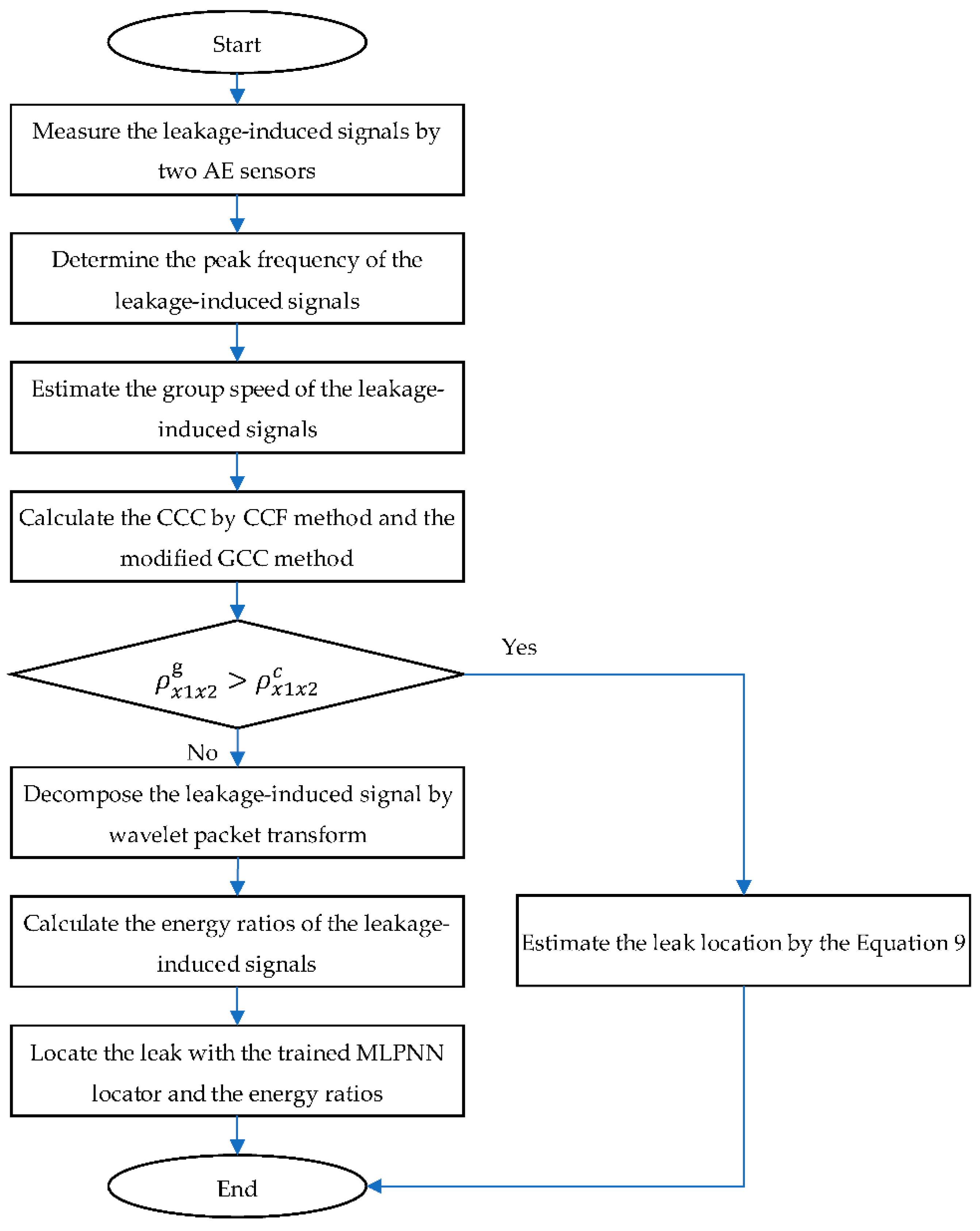
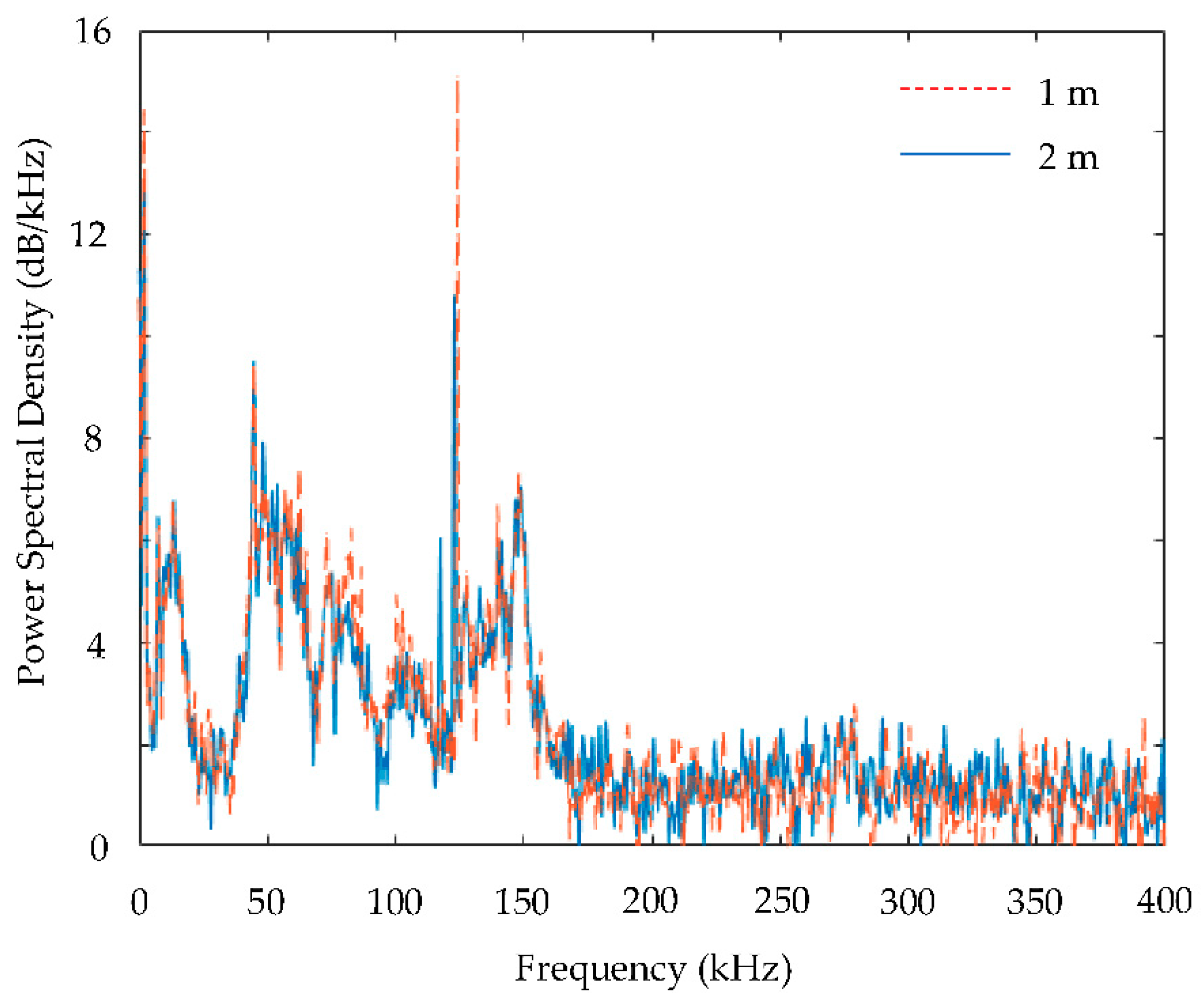
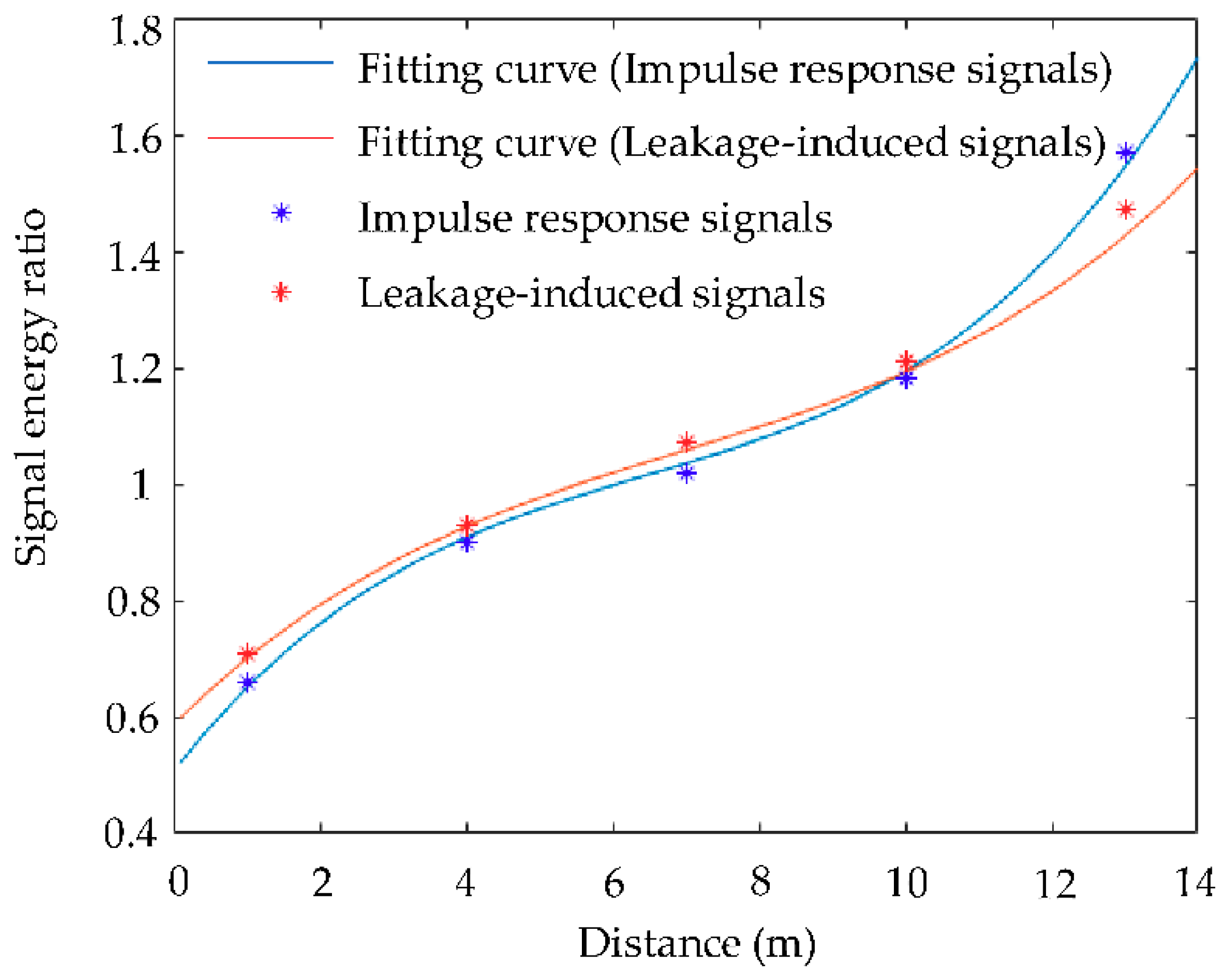
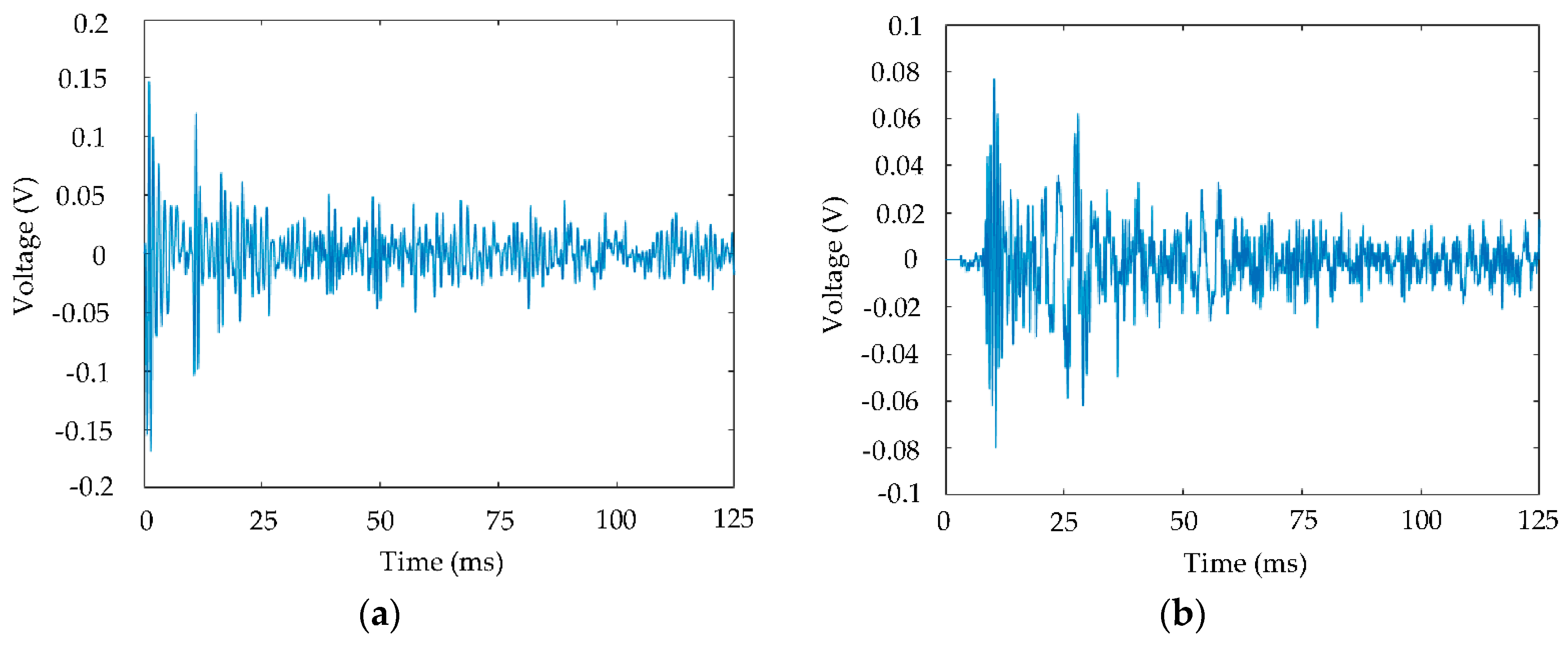
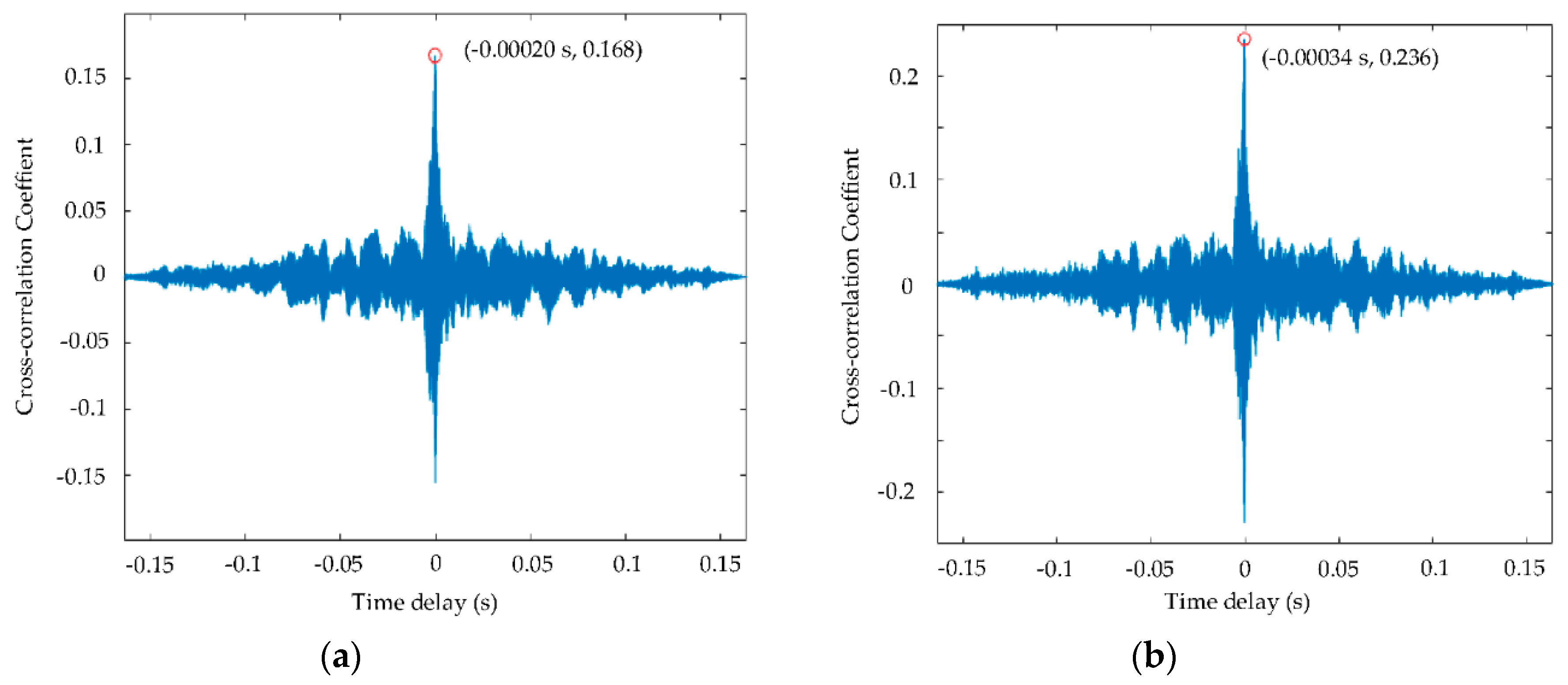
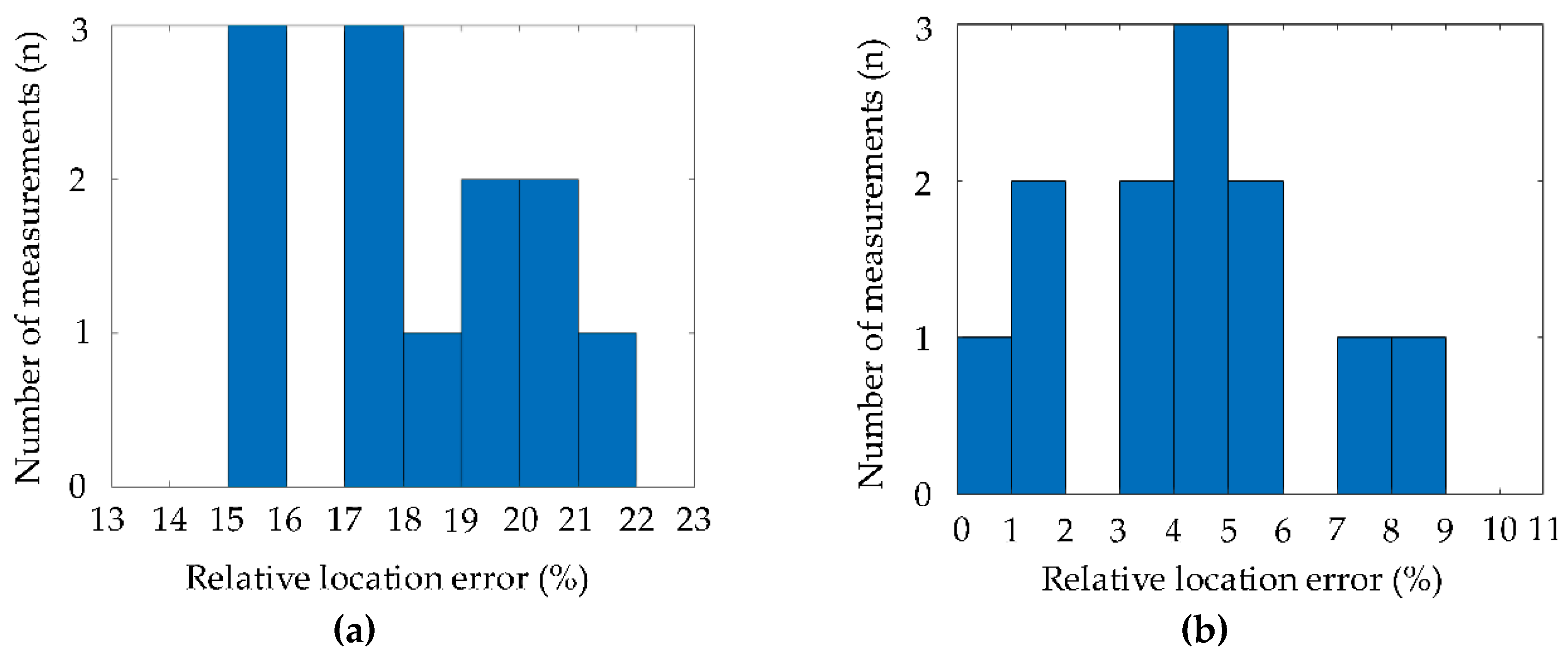
| a (mm) | b (mm) | μ | ρ (kg/m3) | G (GPa) | E (GPa) |
|---|---|---|---|---|---|
| 13.9 | 16.7 | 0.35 | 8000 | 76 | 205 |
| L (m) | 3.24 | 3.24 | 3.24 | 3.24 | 4.52 | 4.52 | 4.52 | 4.52 | 5.70 | 5.70 | 5.70 | 5.70 |
|---|---|---|---|---|---|---|---|---|---|---|---|---|
| f (kHz) | 124.2 | 123.8 | 123.4 | 125.4 | 105.5 | 103.4 | 107.2 | 106.7 | 104.7 | 104.3 | 104.7 | 103.5 |
| v (m/s) | 2404 | 2400 | 2397 | 2415 | 2200 | 2173 | 2222 | 2215 | 2190 | 2186 | 2190 | 2175 |
| l1 (m) | 2.16 | 2.16 | 2.16 | 2.16 | 2.16 | 2.16 | 2.16 | 2.16 | 2.16 | 2.16 | 2.16 | 2.16 |
| (m) | 1.78 | 1.71 | 1.82 | 1.72 | 1.70 | 1.77 | 1.75 | 1.79 | 1.83 | 1.74 | 1.79 | 1.83 |
| ∆l1 (m) | 0.38 | 0.45 | 0.34 | 0.44 | 0.46 | 0.39 | 0.41 | 0.37 | 0.33 | 0.42 | 0.37 | 0.33 |
| δl1 (%) | 17.6 | 20.1 | 15.7 | 20.4 | 21.3 | 18.1 | 19.0 | 17.1 | 15.3 | 19.4 | 17.1 | 15.3 |
| L (m) | 3.24 | 3.24 | 3.24 | 3.24 | 4.52 | 4.52 | 4.52 | 4.52 | 5.70 | 5.70 | 5.70 | 5.70 |
|---|---|---|---|---|---|---|---|---|---|---|---|---|
| f (kHz) | 124.2 | 123.8 | 123.4 | 125.4 | 105.5 | 103.4 | 107.2 | 106.7 | 104.7 | 104.3 | 104.7 | 103.5 |
| v (m/s) | 2404 | 2400 | 2397 | 2415 | 2200 | 2173 | 2222 | 2215 | 2190 | 2186 | 2190 | 2175 |
| l1 (m) | 2.16 | 2.16 | 2.16 | 2.16 | 2.16 | 2.16 | 2.16 | 2.16 | 2.16 | 2.16 | 2.16 | 2.16 |
| (m) | 2.19 | 2.18 | 2.20 | 2.25 | 2.26 | 2.09 | 2.25 | 2.27 | 1.99 | 2.23 | 2.28 | 1.98 |
| ∆l1 (m) | 0.03 | 0.02 | 0.04 | 0.09 | 0.10 | 0.07 | 0.09 | 0.11 | 0.17 | 0.07 | 0.12 | 0.18 |
| δl1 (%) | 1.4 | 0.9 | 1.9 | 4.2 | 4.6 | 3.2 | 4.2 | 5.1 | 7.9 | 3.2 | 5.6 | 8.3 |
© 2019 by the authors. Licensee MDPI, Basel, Switzerland. This article is an open access article distributed under the terms and conditions of the Creative Commons Attribution (CC BY) license (http://creativecommons.org/licenses/by/4.0/).
Share and Cite
Wu, Q.; Lee, C.-M. A Modified Leakage Localization Method Using Multilayer Perceptron Neural Networks in a Pressurized Gas Pipe. Appl. Sci. 2019, 9, 1954. https://doi.org/10.3390/app9091954
Wu Q, Lee C-M. A Modified Leakage Localization Method Using Multilayer Perceptron Neural Networks in a Pressurized Gas Pipe. Applied Sciences. 2019; 9(9):1954. https://doi.org/10.3390/app9091954
Chicago/Turabian StyleWu, Qi, and Chang-Myung Lee. 2019. "A Modified Leakage Localization Method Using Multilayer Perceptron Neural Networks in a Pressurized Gas Pipe" Applied Sciences 9, no. 9: 1954. https://doi.org/10.3390/app9091954





